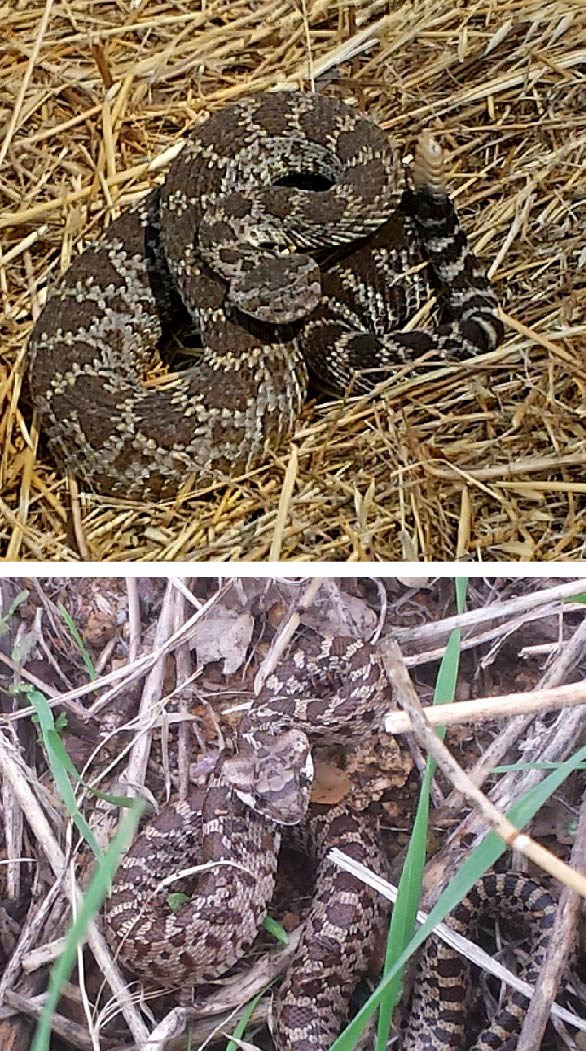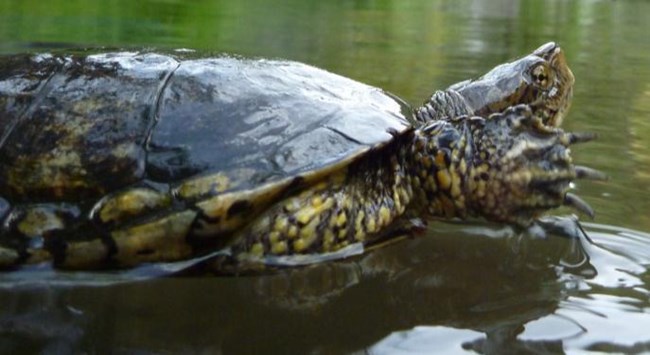|
These parks are home to 21 species of reptiles. As you walk along the trails, you may hear scuffling in the dry leaves as a southern alligator lizard goes after an insect, or see a male western fence lizard doing push-up motions on a rock – displaying its blue underside as a warning to other males and an attractant to females. Or, if you are hiking along a stream at lower elevations, watch for a western pond turtle basking on a rock. Keep your eyes open for these cold-blooded creatures: they are fascinating to watch and learn about. Fourteen of the parks' reptile species are snakes, five are lizards, one is a skink, and one is a turtle. You can get a complete checklist by visiting the NPSpecies tool below. 
NPS Photos - Tony Caprio and Linda Mutch A Tale of Two SnakesWhile many fear the venomous western rattlesnake that inhabits these parks, most rattlesnake bites of people occur when the snake is being harassed or handled inappropriately. It is important to take precautions when hiking in areas where you may encounter a rattlesnake, such as avoiding tall grasses or shrubby areas where visibility is poor, wearing sturdy shoes, walking with a flashlight if out at night, and being ready to step back if you do encounter a rattlesnake. Give it space and the snake will leave you alone. It is always a good idea to hike with awareness, using all of your senses. Some types of non-venomous snakes mimic rattlesnakes, in order to frighten away potential predators, or humans. In these parks, the gopher snake does a convincing imitation of a rattlesnake. See the accompanying images. When frightened, a gopher snake will flatten its head (to make it look bigger like a rattlesnake), coil, hiss, and “rattle” its tail in the dry grasses. While gopher snakes can ward off many threats this way, a skilled observer will notice that the gopher snakes have no rattles, their heads and bodies are more slender, their eye pupils are round compared to the vertical “cat-like” pupils of rattlesnakes, and rattlesnakes have heat-sensing pits between their nostrils and their eyes. When you encounter a snake or any other wild animal – watch from a safe distance; do not handle, harm, or threaten it; and enjoy learning about its behavior. 
Photo by Erik Meyer Western Pond TurtlesIn water, these turtles are typically found in low gradient pool habitat hiding under banks, boulders, and submerged vegetation, or basking on logs and boulders. They will also bask while on land, but the terrestrial environment is largely important for nesting, aestivation (similar to hibernation), and travel. Western pond turtles primarily feed in water, consuming a variety of insects. Western pond turtles are California’s only widespread native turtle. Although their common name implies residence of lakes and ponds, these habitats are rare throughout their range in the Sierra Nevada, where they inhabit streams ranging up to 5000 feet in elevation. Western pond turtles are a California Species of Special Concern. Threats include non-native invasive species such as bullfrogs and trout, habitat loss, disease, contaminants such as pesticides and mercury, and climate-related stress such as drought and warming temperatures. More InformationGet a checklist of reptiles in these parks by visiting the NPSpecies page and selecting Sequoia and Kings Canyon National Park and Reptiles. |
Last updated: October 3, 2023
